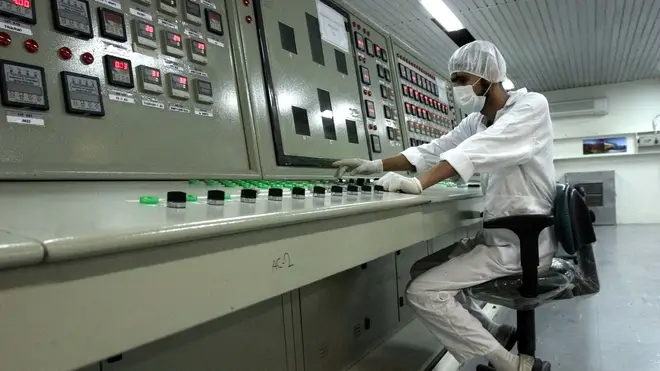
Vanessa Feltz 3pm - 6pm
14 January 2021, 15:54

Iran says its plans to conduct research and development on uranium metal production are part of its ‘declared aim to design an improved type of fuel’.
Iran has told the United Nations’ atomic watchdog agency that it has begun installing equipment for the production of uranium metal, in what would be another violation of the landmark nuclear deal with world powers, the organisation said.
Iran maintains its plans to conduct research and development on uranium metal production are part of its “declared aim to design an improved type of fuel”, the Vienna-based International Atomic Energy Agency (IAEA) said.
But uranium metal can also be used for a nuclear bomb and research on its production is specifically prohibited in the so-called Joint Comprehensive Plan of Action (JCPOA) signed with world powers in 2015.
The ultimate goal of the deal is to prevent Iran from developing a nuclear bomb, something Iran insists it does not want to do. Iran now has enough enriched uranium to make a bomb, but nowhere near the amount it had before the nuclear deal was signed.
IAEA inspectors visited the Isfahan plant where Iran has said it plans to conduct the research on January 10, and officials were informed by Tehran on January 13 that “modification and installation of the relevant equipment for the mentioned R&D activities have been already started”, the agency said.
Iran’s ambassador to the IAEA, Kazem Gharibabadi, repeated that in a tweet on Wednesday, adding that “natural uranium will be used to produce uranium metal in the first stage”.
He told Iran’s official news agency IRNA that the move would elevate Iran to the level of “progressive nations in production of new fuels”.
It was the latest in a string of violations of the JCPOA that Iran has undertaken since President Donald Trump pulled the United States unilaterally out of the deal in 2018, saying it needed to be renegotiated.

Tehran has been using the violations to put pressure on the other signatories — Britain, France, Germany, China and Russia — to provide more incentives to Iran to offset crippling American sanctions reimposed after the US left the deal.
President-elect Joe Biden, who was vice president when the JCPOA was negotiated, has said he hopes to return the US to the deal.
But Britain, France and Germany said last week that Iran “risks compromising” chances of diplomacy with Washington after Tehran announced another violation — that it was starting to enrich uranium to 20% purity, a technical step away from weapons-grade levels of 90%.
The foreign ministers of the three European nations said in a joint statement then that the Iranian activity “has no credible civil justification”. They said the enrichment was a clear violation of the deal and “further hollows out the agreement”.
Germany’s foreign ministry had no immediate comment on Thursday, but the announcement on the production of uranium metal now further complicates trying to get Washington back on board.
Those working to save the deal also note that despite the violations, Iran continues to allow inspectors to access all sites in the country.
Meanwhile, Iran has fired cruise missiles on Thursday as part of a naval drill in the Gulf of Oman, state media reported.

This comes amid heightened tensions with the US over Iran’s nuclear programme and an American pressure campaign against the Islamic Republic.
State TV showed footage of missiles being launched from both land units and ships at sea but did not elaborate on their range or other details.
In July, Iran said it test-fired cruise missiles with a range of some 280km (275 miles).
“Enemies should know that any violation and invasion of Iranian marine borders will be targeted by the cruise missiles from both coast and sea,” Admiral Hamzeh Ali Kaviani, spokesman for the exercise, said.
The two-day drill began on Wednesday when the country’s navy inaugurated its largest military vessel.
And it took place under surveillance of what appeared to be a US nuclear submarine dispatched to the region amid heightened tensions.
Helicopter footage of the exercise released by Iran’s navy showed what resembled an Ohio-class guided-missile submarine, the USS Georgia, which the US navy last month said had been sent to the Persian Gulf — a rare announcement aimed at underscoring American military might in the region.
Iran’s navy did not identify the submarine but warned the boat to steer clear of the area.